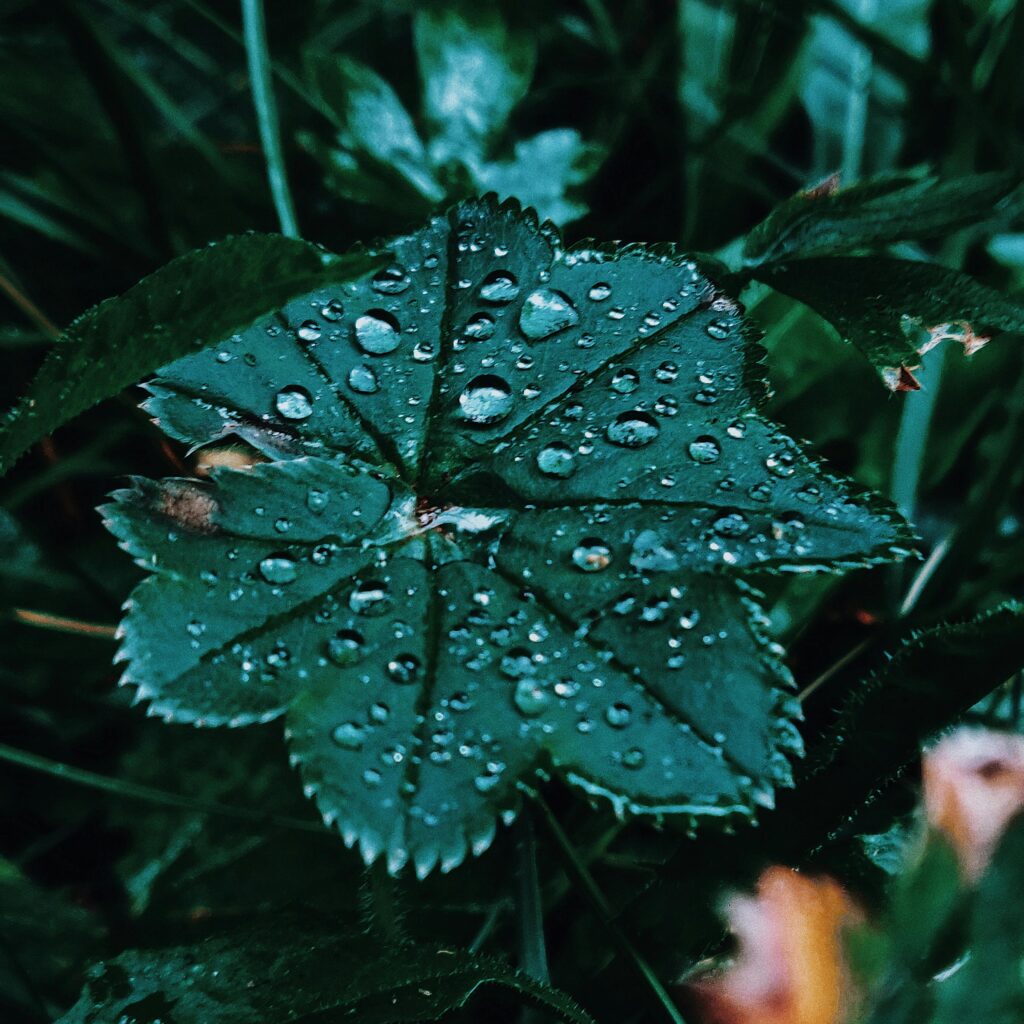Geographical Origin & Distribution
Alchemilla species are native to cool and temperate regions of the Northern Hemisphere. The plant likely originated in the mountainous regions of Europe and spread across various parts of the world due to its adaptability to different climates and altitudes.
Historical Use
Alchemilla, commonly known as Lady’s Mantle, is a perennial herb belonging to the Rosaceae family. Alchemilla is best known for its distinctive fan-shaped, serrated leaves that often catch droplets of dew, which were historically thought to have magical properties by alchemists, hence the name “Alchemilla”. The dewdrops that collected on the leaves in the early morning were thought to be sacred, and the plant was associated with purity and protection.
Medical Use
Alchemilla leaves are mostly used in medicine but the root also has virtually identical properties to the leaves. Harvest the fresh younger leaves during the summer months (before or during flowering) preferably on a dry sunny day when there is little moisture in the air. The roots can be cut in early spring, just as the first shoots appear, or in autumn, once the whole plant is dying back. Harvest from plants at least 2 years old. If drying for storage, lay the leaves and/or roots out on a tray or paper and dry slowly – keep checking regularly for any signs of mould.
Leaves
Large, rounded, and lobed with a serrated edge. The leaves are known to hold water droplets, which can look quite striking.
Flowers
Small, greenish-yellow, and appear in loose clusters. They bloom from late spring to summer.
Size
It grows to about 30–45 cm (12–18 inches) in height and forms a low-growing mound.
Growing Conditions
Alchemilla is often found in alpine and subalpine regions, thriving in mountain meadows, hillsides, valleys, and near streams and rivers. It prefers temperate & cool climates with moderate rainfall and moist, shaded areas.

Active Substances
- Tannins: contribute to its astringent properties, useful for tightening tissues and stopping bleeding. These include agrimoniin, pedunculagin, and laevigatin.
- Flavonoids: quercetin, isoquercetin, rutin, avicularin, proanthocyanidins, and tiliroside – these have antioxidant effects, helping to protect cells from oxidative stress.
- Phenolic Acids: ellagic, gallic & caffeic acid contribute to the plant’s antioxidant and anti-inflammatory properties.
- Salicylic Acid: anti-inflammatory and pain-relieving properties.
- Triterpenes: anti-inflammatory and antimicrobial effects. These include ursolic acid, 2α-hydroxyursolic acid, tormentic acid, euscophic acd, and oleanolic acid.
- Voletile Oils: aroma.
- Phytosterols: help to balance cholesterol levels and provide anti-inflammatory effects.
- Bitters: stimulate digestive secretions, including saliva, bile, and stomach acids.
Chemical Breakdown (per 100g of dried Alchemilla)
Tannins: 6.0-8.0%
Flavonoids: 1.0-3.0%
Salicylic Acid: traces
Phenolic Acids: 0.5%–1.0%
Triterpenes: 0.2-0.5%
Volatile Oils: traces
Phytosterols: traces
Bitters: 1.0-2.0%
Uses of Alchemilla for Horses & Dogs
While Alchemilla is generally considered safe for horses and dogs, it’s important to introduce any new plant or supplement gradually and monitor your animal’s response. Don’t feed to pregnant animals!
- Hormonal Conditions:
- Female Health: Alchemilla is sometimes used to help regulate a reproductive cycle and manage symptoms of hormone imbalances, such as mood swings, irregular estrous cycles, or discomfort during a heat cycle.
- General Hormonal Health: It may support overall hormonal health, promoting better moods and behavior in horses & dogs, especially in mares during the breeding season.
- Wound Healing and Anti-inflammatory Properties:
- Alchemilla contains Tannins and has astringent properties, which may help with minor cuts, abrasions, or inflamed tissues. It can be applied as a poultice or in herbal washes for wounds, reducing inflammation, promoting healing and reduce itchiness.
- Digestive Health:
- It may be used to support digestive health due to its mild astringent effect, which can help soothe and tone the mucous membranes of the digestive tract.
- Blood Cleansing & Haemostatic Properties
- Alchemilla shows the ability to stop or slow bleeding, both internally and externally. This makes it a valuable plant for conditions where bleeding needs to be controlled.
Additional sources: National Center for Biotechnology Information; Royal Society of Chemistry; MDPI – Optimization of Deep Eutectic Solvent Extraction of Phenolic Acids and Tannins from Alchemilla vulgaris L.; Science Direct – A review of the traditional uses, phytochemistry, pharmacology, and clinical evidence for the use of the genus Alchemilla (Rosaceae)
